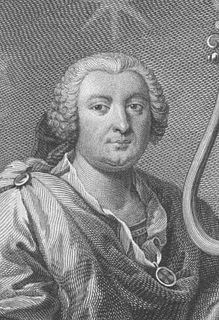
Jean (Jehan) Titelouze was a French composer, poet and organist of the early Baroque period. His style was firmly rooted in the Renaissance vocal tradition, and as such was far removed from the distinctly French style of organ music that developed during the mid-17th century. However, his hymns and Magnificat settings are the earliest known published French organ collections, and he is regarded as the first composer of the French organ school.
Antonio Francisco Javier José Soler Ramos, usually known as Padre Antonio Soler, known in Catalan as Antoni Soler i Ramos was a Spanish Catalan composer whose works span the late Baroque and early Classical music eras. He is best known for his many mostly one-movement keyboard sonatas strongly influenced by Domenico Scarlatti, which constitute a very important, quite underrated, contribution to the harpsichord, fortepiano and organ repertoire.

Antonio de Cabezón was a Spanish Renaissance composer and organist. Blind from childhood, he quickly rose to prominence as a performer and was eventually employed by the royal family. He was among the most important composers of his time and the first major Iberian keyboard composer.

José António Carlos de Seixas was a pre-eminent Portuguese composer of the 18th century. An accomplished virtuoso of both the organ and the harpsichord, Seixas succeeded his father as the organist for Coimbra Cathedral at the age of fourteen. In 1720, he departed for the capital, Lisbon, where he was to serve as the organist for the royal chapel, one of the highest offices for a musician in Portugal, a position which earned him a knighthood. Much of Seixas’ music rests in an ambiguous transitional period from the learned style of the 17th century to the galant style of the 18th century.

Claudio Merulo was an Italian composer, publisher and organist of the late Renaissance period, most famous for his innovative keyboard music and his ensemble music composed in the Venetian polychoral style. He was born in Correggio and died in Parma. Born Claudio Merlotti, he Latinised his surname when he became famous in Venetian cultural clubs.

Francisco Bartolomé Sanz Celma, better known as Gaspar Sanz, was a Spanish composer, guitarist, organist and priest born to a wealthy family in Calanda in the comarca of Bajo Aragón, Spain. He studied music, theology and philosophy at the University of Salamanca, where he was later appointed Professor of Music. He wrote three volumes of pedagogical works for the baroque guitar that form an important part of today's classical guitar repertory and have informed modern scholars in the techniques of baroque guitar playing.
Jacques Brunel was a French organist and composer, active mostly in Italy.
Juan Bautista José Cabanilles was a Spanish organist and composer at Valencia Cathedral. He is considered by many to have been the greatest Spanish Baroque composer, and has been called the Spanish Bach.
Girolamo (Hieronimo) Cavazzoni was an Italian organist and composer, son of Marco Antonio Cavazzoni. Little is known about his life except that he worked at Venice and Mantua, and published two collections of organ music. These collections only contain music written before about 1549, but are of high quality, and established the traditional form of imitative ricercars and canzonas.
Sebastian Aguilera de Heredia was a Spanish monk, musician and composer.
Manuel Orlandi Blasco de Nebra was a Spanish organist and composer who lived in Seville.

Hernando de Cabezón, was a Spanish composer and organist, son of Antonio de Cabezón. Only a few of his works are extant today, and he is chiefly remembered for publishing the bulk of his father's work.
Jesús Guridi Bidaola was a Spanish Basque composer who was a key player in 20th century Spanish and Basque music. His style fits into the late Romantic idiom, directly inherited from Wagner, and with a strong influence from Basque culture. Among his best known works are the zarzuela El Caserío, the opera Amaya, the orchestral work Ten Basque Melodies and his organ works, where the Triptych of the Good Shepherd can be highlighted.
José Melchor Baltasar Gaspar Nebra Blasco was a Spanish composer. His work combines Spanish traditions with the Italian style of his day.
José de Torres y Martínez Bravo was a Spanish composer, organist, music theorist and music publisher.
Cristóbal Galán was a Spanish Baroque composer.
Juan del Vado y Gomez (1625–1691) was a Spanish composer, organist and violinist. He is noted for the enigmatic canons, symbolic musical puzzles, dedicated to his king Charles II of Spain.
Giuseppe Gherardeschi was an Italian organist and composer. He was born and died in Pistoia.
Montserrat Torrent i Serra is a Spanish organist.

Jesús de Monasterio y Agüeros was a Spanish violinist, composer, conductor and teacher. He was one of the main promoters of Madrid instrumental music during the nineteenth century.















